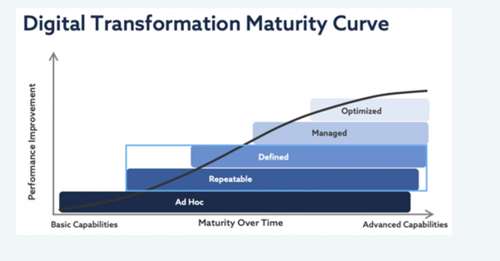Digital Maturity: what it is and how to achieve it
Date: Monday, January 17, 2022
Digital or die. It sounds dramatic, but without the right digital strategy it's getting harder and harder for businesses to thrive.
Digital-first is no longer just a consideration, for most organisations it's a necessity. Leaders need to get strategies in place that are actionable now and agile enough to flex to future developments.
What is digital maturity and why does it matter?
You've probably heard the term, but what does it really mean? Digital maturity is essentially a measure of how well an organisation can respond to technological trends. How well it can look at the ever-changing digital environment and adapt its processes and strategies to meet the needs of their customers.
It's important to think of digital maturity less as an end goal and more of an ongoing process. Technology is constantly changing, and organisations need to be ready to change with it.
Digital maturity should be at the heart of every organisation’s growth strategy. And while it is a significant undertaking, it will play a key role in business performance, will increase revenue and customer satisfaction, and deliver a competitive advantage.
A journey needs a baseline
So, you know you need digital maturity, but before you can progress to it you need to know where you currently stand. A digital maturity assessment can give you the baseline you need to get the right strategies in place for your digital transformation.
An assessment should look at things like your technological infrastructure, operating models, and customer processes, but also things like culture, attitude, and values in your organisation.
This information will help you to assess your organisation’s digital maturity and give you the insight you need to develop a detailed roadmap for your digital transformation.
The digital maturity curve
IBM has developed a framework for digital transformation that is neatly summarised in their digital maturity curve, it's a useful tool for assessing your current digital status.

The curve shows how digitally mature an organisation is based on its technological capabilities.
Each stage can be defined as follows:
Ad hoc: Little or no systems, efforts mainly based on the work of individuals with no organisation-wide support or clear processes in place
Repeatable: Decentralised systems and processes – a siloed and disparate approach that is dependent on individual efforts.
Defined: Basic processes and roles defined, and standard enterprise-wide systems implemented.
Managed: Roles and processes implemented at an enterprise-wide level with fully-integrated systems and monitored and evaluated performance indicators.
Optimised: Continuous improvement through real-time feedback loops, enhanced analytics and social collaboration.
Understanding where your organisation sits on the digital maturity curve can help you set short and long-term goals to progress your digital transformation.
The foundations for digital transformation
There isn’t a one size fits all for digital transformation. The size, structure and industry you operate in will all dictate the goals and priorities on your journey to digital maturity.
But there are foundations that organisations of every size and in every field need to have in place to stand the best chance of achieving the right digital transformation.
Strategy
For digital maturity to be realised effectively it needs to be part of your wider strategy. A digital first approach should be embedded across all parts of your organisation – not just an add-on.
Committed leadership
A commitment to digital transformation needs to come from the top. Forecasting and adapting to the ever-evolving digital landscape takes vision and strong leadership. It’s a long-term process.
Embracing change and innovation
To take an organisation to digital maturity takes fresh thinking and new mindsets. Those in leadership positions must instil a culture of innovation and experimentation and empower teams to challenge and improve ways of working.
Streamlined processes
Key to digital maturity is agility and flexibility. Processes and practices across the organisation need to be evaluated and consolidated to avoid being barriers to transformation and to be readied to respond to changes in the digital landscape.
The right structure and skills
A traditional hierarchical structure isn’t the natural ally to digitally mature organisations. A more agile and responsive structure can enable a more timely and efficient response to digital challenges. Getting the right input at the right time from digital specialists is also key. Whether that’s recruiting new talent to your team or getting support from third party specialists, this insight can help you achieve sustainable digital maturity.
Key benefits of digital maturity
If an organisation is digitally mature the benefits reach way beyond the systems and technology that underpin it. The customer experience will be improved and with that comes increased engagement and retention. Internally it brings a more skilled workforce, stronger company culture, collaboration and better employee engagement. On a strategic level you will get better data-led insights, will be able to operate more efficiently and have greater resilience. All which contributes to competitive advantage and financial growth.
Is there a right time to start the process?
Digital maturity is an ongoing commitment. As technology evolves and the digital environment shifts, organisations must shift too. That means it's always the right time to set the wheels in motion. Leaders who understand and embrace digital maturity will give their organisation the best platform for growth and success.
About Village Software
Village Software Engineering design and build incredible software solutions with the single aim of improving your business. Our team of innovative and skilled developers work across many sectors including manufacturing, education, transportation and logistics, healthcare, utilities and retail.
We provide application development, enterprise integration and business intelligence software solutions that embrace leading edge technologies and methods. Our curiosity and intelligent thinking help us to deliver quality solutions that don’t just work but work for you.
Get in touch
We’d be delighted to talk to you about how we can help your business evolve your digital maturity. Just get in touch for a chat.
villagesoftware.co.uk
+44 (0)151 7097728
The Tempest 12 Tithebarn Street, Liverpool L2 2DT
 About Us
About Us Services
Services Sectors
Sectors Case Studies
Case Studies Blog
Blog Contact
Contact



